Corporate Guide
History of the Takara Group
-
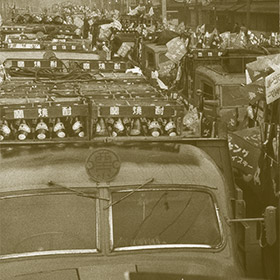
-
- Chapter 2
-
Recovery from War and Japan’s High-Growth Period
1945–1966
Business expansion and Takara’s entry into the beer market
-
-
1
Recovery from War and Japan’s Economic Miracle
-
1945
-
Kurakichi Ohmiya becomes the third president
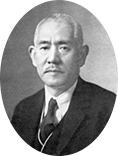
The Pacific War ended on August 15, 1945. Japanese society was in a state of confusion and dire poverty. Takara Shuzo had forfeited Manshu Shochikubai Shuzo and all other overseas assets, and its production facilities in Japan were in complete ruin. Even as the company tried to resume production, it was short of raw materials for shochu, and even staple foods such as rice and potatoes were in short supply. Hardship followed hardship and despair followed despair. Usaburo Yomo passed away, followed by Hidesaburo Yomo a few months later. In December of the same year, amidst the deep sorrow occasioned by these losses, Kurakichi Ohmiya (photo) was appointed as the third president to carry on the legacy of his predecessors and the mission to grow the company's business.
-

1946
-
Three Points of Importance, Three Points of Care
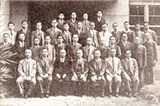
On the first workday of the new year in 1946,
Kurakichi announced a new company motto: "Three Points of Importance, Three Points of Care." Since its founding, the company had emphasized the importance of harmony in business management, but as the company's structure had become more complex, Kurakichi felt more concrete guidelines to be necessary.
The "Three Points of Importance" referred to:
1. The importance of civility;
2. The importance of the law;
3. The importance of loyalty*
The "Three Points of Care" referred to:
1. Care with words and actions;
2. Care with fire;
3. Care with machinery.
Kurakichi also explained the importance of perseverance in putting these ideas into action and strongly encouraged his employees to embrace these values and cooperate with each other as they forged ahead with courage based on this spirit. (Photo: Taken in commemoration of the inauguration of President Kurakichi Ohmiya.)
* In 1965, "loyalty" was replaced with "responsibility." -

1947
-
Building momentum through acquisitions

In June 1947, the Shirakawa Plant (photo) was established by purchasing and renovating a plant owned by Daikoku Budoshu in Fukushima Prefecture, and began manufacturing shochu, wine, whiskey, brandy, and other products. In the same year, with the full implementation of the Antimonopoly Act, the company had to divest itself of Daikoku Budoshu and Shochikubai Shuzo, which became independent businesses. On the other hand, Takara Shuzo successfully acquired Nihon Shusei KK and Asahi Shuzo KK, putting in place the infrastructure for a full recovery.
-

-
-
1
-
-
2
The drink of the common man: shochu’s rising popularity
-
1949
-
Free selling resumes and shochu sales surge
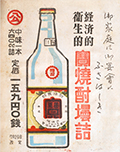
In 1949, the Liquor Rationing Board was dissolved and restrictions on the supply of sweet potatoes as a raw material were lifted, and with the return of free selling, demand for relatively inexpensive shochu was increasing dramatically. In 1949, shochu jumped to the top of alcoholic beverages in terms of sales volume. There was also a flood of orders for shochu in bottles and ceramic jugs, and production could hardly keep up with demand. A stock exchange was established that year, and the shares of Takara Shuzo were listed on it. (Photo: An advertisement for Takara Shochu)
-

1950
-
Major growth as Japan’s top shochu brand
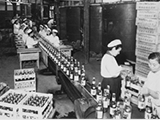
In 1950, the Japanese economy suddenly boomed due to special demand from the Korean War, and the popularity of shochu continued to climb. This led to the rapid proliferation of competitors and a cutthroat market, eventually resulting in the promulgation of a Ministry of Finance ordinance placing restrictions on shochu shipments. Yet even under these conditions, Takara Shochu continued to build momentum, winning an unassailable position as the market's top brand. In 1950, in particular, a special sales promotion whipped up demand that production could not keep up with even with all plants operating a full capacity. (Photo: Bottling of Takara Shochu)
-

-
-
2
-
-
3
Major mergers and expansion of the production base
-
1951
-
Yutaka Tanaka becomes the 4th president of Takara Shuzo
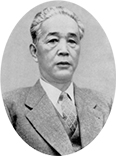
Takara Shuzo celebrated its 25th anniversary in 1950. The following year, in 1951, Yutaka Tanaka (photo) became the company's fourth president and Kurakichi Ohmiya became chairman. Under the new leadership, the company continued on its expansion path by actively pursuing major mergers and capital increases.
-

1952
-
Merger with Chuo Shurui and becoming a major manufacturer of distilled alcohol
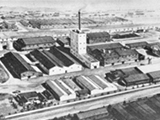
In 1952, Takara Shuzo joined the ranks of leading distilled alcohol manufacturers through its merger with Chuo Shurui KK. As a result of the merger, the Nada-Uozaki Plant of Shochikubai Shuzo, which Chuo Shurui had previously acquired, returned to the company's fold. That same year, government-operated alcohol production facilities were put on sale to the public, and Takara Shuzo successfully bid on the Shimabara Plant in Nagasaki and the Takanabe Plant (presently Kurokabegura) in Miyazaki. Further, in 1954, the company purchased the Nada No. 2 Plant (presently Shirakabegura) (photo) from Settsu Shuzo KK, giving it a total of 14 production facilities throughout Japan.
-

-
-
3
-
-
4
Shochu sales soften and mirin becomes a household item
-
1955
-
Improved standard of living and weakened shochu sales
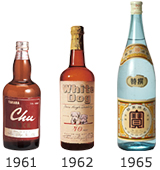
Shochu, which was popularly known as "the drink of the common man" during the postwar reconstruction period, gradually saw its appeal wane as the standard of living improved with the high growth of the Japanese economy. After peaking in 1955, sales of Takara Shochu suffered from the growing popularity of beer, whisky, and other Western-style liquors. However, undaunted in the face of adversity, Takara Shuzo continued to improve the quality of its shochu products. In 1963, Takara Shuzo adopted the industry’s first vacuum distillation method and succeeded in producing tasteless and odorless alcohol with almost no impurities. The company also continued to assiduously develop new products, launching Chu-Rock, White Dog, and 30% ABV Takara Shochu (Photo). In response to the popularity of Western-style alcoholic beverages, Takara Shuzo strengthened its lineup of domestically produced whiskeys such as King and Ideal, and other products such as Takara port wine, steadily rounding up its offering of alcohol products.
-

1959
-
From professional use to household use—growing popularity and falling taxation of mirin

Alongside shochu, the other pillar of Takara Shuzo’s business was mirin. Until the mid-1950s, mirin, originally a rather luxurious form of alcohol, taxed at a high rate, was used almost exclusively by professional cooks and only rarely by housewives preparing food at home. In response to this situation, the Japan Mirin Makers Association was formed by mirin manufacturer supporters. Proactive campaigning to reduce the tax rate for mirin resulted in two separate downward revisions, once in 1959 and once in 1962, reducing the tax rate to less than half and making mirin a more affordable product. Around the same time, the industry began to advertise mirin as a household cooking condiment, and its use was promoted in cooking classes all over Japan. The sum effect of all these activities was a steady increase in demand for mirin among housewives. (Photo: Poster announcing a price reduction due to a tax cut)
-

-
-
4
-
-
5
The challenge and frustration of brewing beer
-
1954
-
The dream of Takara Beer takes off
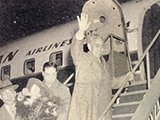
In 1954, Takara Shuzo made a major decision: to enter the beer business. Kurakichi Ohmiya set out on a tour of Europe and the U.S. in preparation for this. Accompanied by two production engineers, Kurakichi traveled from Italy to Munich, Germany, where he visited Steinecker, a manufacturer of brewing equipment, and signed a tentative purchase order for various equipment. Next, he visited France, Great Britain, and the U.S. to tour a number of breweries before continuing home to Japan loaded with information. Back in Japan, he applied for a license to brew beer at the Kizaki Plant, which was granted the following year, in 1955. In the meantime, to develop a product that would outclass the competition, researchers were sent to Germany, and a wide range of studies were undertaken. (Photo: Chairman Kurakichi Ohmiya departing at Haneda Airport)
-

1957
-
Takara Beer launches
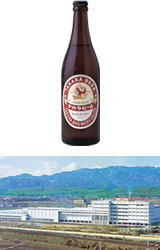
In 1957, Takara Beer at last was launched. Combining full-bodied flavor with German-style bitterness, it was the first Japanese beer to be offered in 500-ml bottles. However, the strong networks of distributors of existing manufacturers were more impenetrable than expected, and unable to secure a sales network, Takara Shuzo was forced to establish its own sales company and conduct beer wholesale. In 1962, the Kyoto Plant was established to increase demand in the Kansai region. Still, the situation remained unimproved. With the company facing an unprecedented predicament, Kurakichi Ohmiya once again took over as Takara Shuzo’s fifth president even while continuing to serve as chairman of the board to turn things around. However, in 1967, the company finally decided to withdraw from the beer business and ceased operations at the Kizaki and Kyoto Plants. (Photo: The first Takara Beer and the Kyoto Plant)
-

-
-
5

